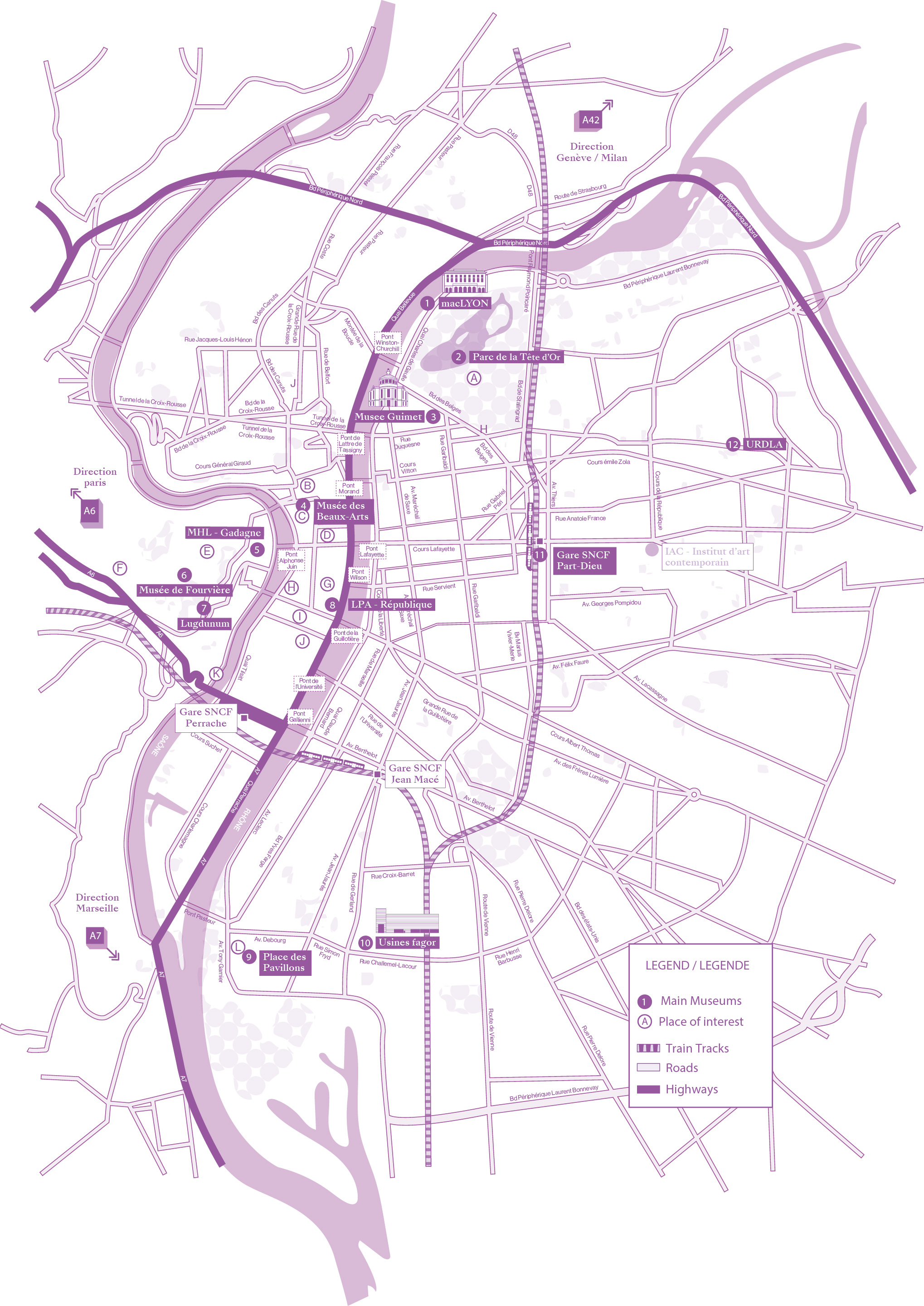
MacLyon
Created in 1984 in a wing of the Palais Saint-Pierre, the Museum of
Contemporary Art of
Lyon
moved to the site of the Cité Internationale in 1995, a vast
architectural complex which
will then extend over more than a kilometer on the edge of the Parc de
la Tête d'Or, in
the
6th arrondissement of Lyon. Entrusted to the architect Renzo Piano, who
designed the
entire
site, the museum retains, on the Park side, the facade of the atrium of
the Palais de la
Foire, designed by Charles Meysson in the 1920s. The 6,000 m2 building,
entirely
modified,
presents, on several levels, modular spaces according to artistic
projects and perfectly
adapted to new forms of contemporary expression.
69006 Lyon
Parc de la Tête D’Or
Designed by the Bühler brothers and laid out in 1857, the Parc de la
Tête d'Or is as
much a
place of relaxation and leisure as it is a botanical and zoological
garden, a rose
garden
and an
orangery. Located on the banks of the Rhône, it also houses the Pavillon
du Parc, a
former
restaurant, empty and abandoned since 2015.
69006 Lyon
Musée Guimet
Inaugurated in 1913 in a building in the 6th arrondissement according to
plans designed
by
Tony Blein and closed to the public since 2007, the Guimet Museum of
Natural History
housed
a wide variety of collections - from non-European ethnology to natural
sciences and
pontifical missionary works.
69006 Lyon
Musée Des Beaux-Arts
The Gallo-Roman museum of the city of Lyon is designed like an
underground concrete
cathedral, anchored on the hill of Fourvière. Inaugurated in 1975, it
stands on the site
of
the Roman city, Lugdunum, founded in 43 BC. The brutalist architecture,
melted into the
landscape, highlights the surrounding archaeological elements and serves
as a showcase
for
the collections. This diachronic layout testifies to the leafing of time
in the city,
and
very contemporary pieces will come to mingle with it.
69005 Lyon
MHL - Gadagne
Located in the heart of Old Lyon, Hotel de Gadagne, built during the
Renaissance by the
Pierrevive brothers, has housed the collections of the Lyon History
Museum since 1921.
Conserving nearly 80,000 pieces, the museum gives an overview of the
different faces of
the
capital of Gaul, which is as much the city of silk as it is of workers'
revolts, of the
chemical and pharmaceutical industries as well as of cinema.
69005 Lyon
Musée de Fourvière
The Fourvière Museum is a private museum of sacred art. Created in 1960,
its primary
vocation was to introduce the public to the wealth of art and the
culture of
Christianity.
The museum also has the treasure of Fourvière, bringing together pieces
of goldsmithery
from
the 19th and 20th centuries. This place, currently under renovation, is
reinventing
itself
to pursue its transmission mission.
69005 Lyon
LUGDUNUM - Museum & Roman Theaters
The Gallo-Roman museum of the city of Lyon is designed like an
underground concrete
cathedral, anchored on the hill of Fourvière. Inaugurated in 1975, it
stands on the site
of
the Roman city, Lugdunum, founded in 43 BC. The brutalist architecture,
melted into the
landscape, highlights the surrounding archaeological elements and serves
as a showcase
for
the collections. This diachronic layout testifies to the leafing of time
in the city,
and
very contemporary pieces will come to mingle with it.
69005 Lyon
LPA - République
Car-park operator LPA was established by the Lyon metro authority in
1969, when Louis
Pradel
was mayor of Lyon, two years before the Fourvière Tunnel opened. In
1989, LPA chairman
Serge
Guinchard brought art into its facilities, with works by leading
contemporary figures
such
as Daniel Buren and François Morellet at the Célestins and République
car parks
respectively. The idea was to make car parks cultural venues accessible
to all,
promoting
interaction between car users and pedestrian visitors.
69002 Lyon
Place des Pavillons
69007 Lyon
Auvergne-Rhône-Alpes
Usines fagor
A former jewel of industry at the heart of Lyon's labor history, the
Fagor-Brandt
household
appliance factory, located in the Gerland district of Lyon, extended
over a 4.5 hectare
site
(110,000 m² including 73,000 m² of covered buildings), today partially
in
rehabilitation.
If, at the beginning of the 1980s, the factory still employed 1,800
workers, they were
just
under 400 in the 2000s. Production was gradually relocated from 2005 and
the factory was
sold to SITL, then to Cenntro Motors in 2010. As it began its conversion
into the
production
of electric cars, the plant declined until its closure in 2015.
The site, currently fallow over 29,000 m2, now hosts cultural events
such as the Nuits
Sonores since 2017, the Lyon Street Food Festival, the Dance and
Contemporary Art
Biennale.
69007 Lyon
Gare SNCF Part-Dieu
Mise en service en 1983, la gare ferroviaire Part- Dieu remplace
l’ancienne gare de
Lyon-Brotteaux. Conçue par Eugène Gachon et Jean-Louis Girodet, elle
voit le jour dans
le
cadre de l’aménagement urbain du quartier de la Part-Dieu, qui accueille
également un
important centre d’affaires ainsi qu’un gigantesque centre commercial.
Elle est la
première
gare européenne par le nombre de voyageurs en correspondance et la
première gare de
province
par le nombre annuel de voyageurs. Elle est également le premier pôle de
correspondance
des
Transports en commun lyonnais, ce qui fait du quartier un véritable hub
métropolitain
contemporain traversé quotidiennement par un demi-million de
déplacements. Dans le cadre
du
grand chantier de réaménagement du quartier, la gare subit actuellement
d’importants
travaux
d’agrandissement.
69003 Lyon
URDLA
Located in Villeurbanne in a former factory, URDLA is a hybrid place
that is both a
production workshop and a dissemination tool. Preserving historic
presses and
century-old
lithographic stones, the space is dedicated to the development and
conservation of
prints.
69100 Villeurbanne